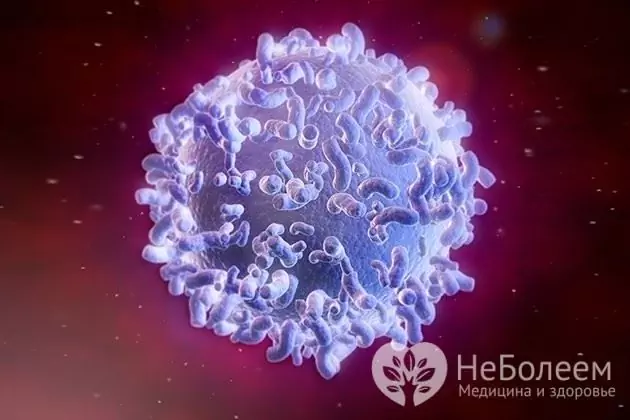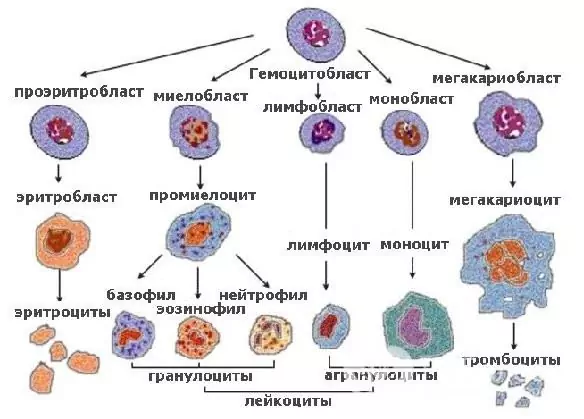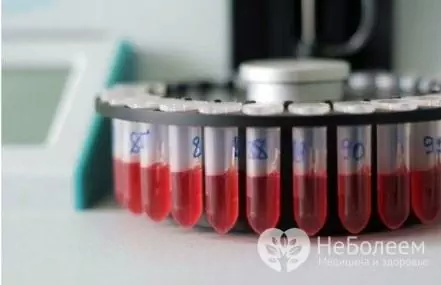- Author Rachel Wainwright [email protected].
- Public 2023-12-15 07:39.
- Last modified 2025-11-02 20:14.
Lymphocytosis
The content of the article:
- Types of lymphocytosis
- Causes of lymphocytosis
- Signs
- Diagnostics
- Lymphocytosis treatment
- Prevention
Lymphocytosis is an increased content of lymphocytes in the peripheral blood - one of the types of leukocytes that belong to the group of agranulocytes.

Lymphocytes are the main cells of the human immune system. Their functions in the body:
- provide cellular immunity - directed against intracellular parasites, viruses, protozoa, fungi, tumor cells;
- provide humoral immunity - the formation of special protein molecules (antibodies) directed against various pathogens (antigens);
- regulate the activity of other types of cells - the destruction of those of them, the structure of which is different from the norm, for example, cancer cells.
Of the total number of leukocytes, the proportion of lymphocytes in a healthy adult is 24-40%, in children, the proportion of lymphocytes can reach 50%.
Lymphocytes are divided into two groups according to morphological characteristics:
- large granular lymphocytes - represented by NB-cells (much less often by immunoblasts and lymphoblasts);
- small lymphocytes - these include B and T cells.
Depending on the functions they perform, lymphocytes are classified into three types.
- T cells. They are directly involved in ensuring cellular immunity. They, in turn, are divided into two types: T-helpers and T-suppressors.
- B cells. They recognize different antigens and produce antibodies of protein structure directed against them.
- NB cells. They actively destroy cells abnormal in structure in various tissues of the body.
Of the total number of lymphocytes, T cells account for 65-80%, B cells - 8-20%, and NK cells - 5-20%.
Types of lymphocytosis
When analyzing peripheral blood, not only the absolute content of lymphocytes per unit of blood volume is calculated, but also the percentage of lymphocytes in relation to the total number of leukocytes is calculated.

In accordance with this, the following types of lymphocytosis in adults and children are distinguished:
- Absolute lymphocytosis. It is characterized by an absolute increase in the content of lymphocytes in the blood (normally 1000-4500 cells in 1 μl), which occurs against the background of an increase in the total number of leukocytes (leukocytosis).
- Relative lymphocytosis. The patient has an increase in the percentage of lymphocytes, more often against the background of a normal or low total number of leukocytes (leukopenia). In clinical practice, it is observed much more often than absolute lymphocytosis.
Depending on the etiological factor underlying the occurrence of lymphocytosis, it is subdivided into reactive and malignant.
The ingestion of an infectious agent causes the development of a response, which leads to reactive lymphocytosis, that is, to a normal reaction of the immune system. In cases where lymphocytosis develops as a result of the body's struggle not with infection, but with cancer cells, they speak of malignant lymphocytosis.
Causes of lymphocytosis
In most cases, lymphocytosis is caused by infectious diseases. The development of absolute lymphocytosis is caused by:
- acute respiratory viral infections (ARVI);
- whooping cough;
- cytomegalovirus infection;
- infectious mononucleosis (Filatov's disease);
- toxoplasmosis;
- brucellosis;
- tuberculosis;
- acute viral hepatitis;
- the initial stages of HIV infection;
- diseases of the lymphatic system (Waldenstrom's macroglobulinemia, chronic lymphocytic leukemia, lymphomas);
- Chagas disease;
- Crohn's disease.
The most common causes of relative lymphocytosis are:
- viral infections;
- hyperthyroidism;
- rheumatic (systemic) diseases;
- typhoid fever;
- massive purulent-inflammatory process;
- splenomegaly (enlarged spleen);
- Addison's disease;
- autoimmune thrombocytopenic purpura.
In addition, relative lymphocytosis is observed in children from birth to two years of age. In this case, it is physiological in nature.
Signs
Lymphocytosis is not an independent pathology, but is one of the laboratory symptoms of very different diseases (in most cases, infectious). Therefore, the signs of lymphocytosis are represented by symptoms of one or another disease, which caused changes in the cellular composition of peripheral blood.
These symptoms include:
- lymphadenopathy (swollen lymph nodes);
- hepatomegaly (enlarged liver);
- splenomegaly (enlarged spleen);
- hyperemia of the pharyngeal mucosa;
- sore throat;
- cough;
- rhinitis;
- general weakness, increased fatigue;
- decreased appetite;
- increased body temperature (possibly with chills);
- sleep disorders;
- increased sweating.
Lymphocytosis in children is often manifested by impaired bowel function:
- nausea, vomiting;
- bloating;
- unstable stools (alternating diarrhea and constipation).
Diagnostics
Diagnosis of lymphocytosis is carried out according to the results of a general (clinical) blood test.

With absolute lymphocytosis in patients, an increased number of lymphocytes is combined with an increase in the total number of leukocytes.
A combination of relative lymphocytosis and thrombocytopenia (a decrease in platelet count) is most commonly seen in autoimmune thrombocytopenic purpura or hypersplenism.
In case of bacterial and viral infections, accompanied by dehydration of the patient (high fever, frequent vomiting, diarrhea), a simultaneous increase in lymphocytes and erythrocytes is detected in the analysis of peripheral blood.
Tuberculosis and many viral infections are accompanied by the development of leukopenia (a decrease in the total number of leukocytes) in combination with relative lymphocytosis.
Lymphocytosis often accompanies cancer. Therefore, if, according to the results of a blood test, lymphocytosis is detected and at the same time the patient does not have any clinical symptoms inherent in an infectious pathology, or an indication of a previous infectious disease, a detailed examination is shown, which, depending on the indications, includes the following methods:
- determination of tumor markers;
- Ultrasound of the abdominal and pelvic organs;
- computed and / or magnetic resonance imaging;
- X-ray research methods;
- fibrogastroduodenoscopy (FGDS);
- biopsy of suspicious lesions detected by diagnostic imaging, followed by histological analysis of tissue samples.
Lymphocytosis treatment
Since lymphocytosis, as mentioned above, is not an independent disease, but only one of the laboratory criteria inherent in many pathologies, its treatment, or rather, the treatment of the disease that caused it, differs in each case.
Physiological lymphocytosis in children does not require therapy. In other cases, the treatment of lymphocytosis should be prescribed only by a doctor, after conducting the necessary examination of the patient and establishing an accurate diagnosis.
For infectious diseases, antibiotics, sulfonamides, antiviral or anti-inflammatory drugs are prescribed to patients according to indications.
Patients with tuberculosis are prescribed a specific therapy for tuberculosis (DOTS + therapy).
Lymphocytosis in patients with malignant diseases (lymphogranulomatosis, lymphocytic leukemia) requires long-term therapy with cytostatic drugs in the form of mono- or polychemotherapy, and in some cases, bone marrow transplantation.
Prevention
Prevention of lymphocytosis is aimed at increasing the defenses of the human body, preventing infection with infectious diseases.

Source: mygazeta.com
It includes the following activities:
- balanced diet;
- observance of the regime of alternation of work and rest;
- active lifestyle (regular physical education, frequent walks in the fresh air, active pastime during the day);
- rejection of bad habits (smoking, alcohol abuse);
- careful adherence to the rules of personal hygiene;
- isolation of patients with infectious diseases;
- vaccination of major infections in accordance with the national immunization schedule;
- regular preventive examinations, this is especially important for people at risk of malignant blood lesions (family history of lymphoma, etc.).
YouTube video related to the article:

Elena Minkina Doctor anesthesiologist-resuscitator About the author
Education: graduated from the Tashkent State Medical Institute, specializing in general medicine in 1991. Repeatedly passed refresher courses.
Work experience: anesthesiologist-resuscitator of the city maternity complex, resuscitator of the hemodialysis department.
The information is generalized and provided for informational purposes only. At the first sign of illness, see your doctor. Self-medication is hazardous to health!






